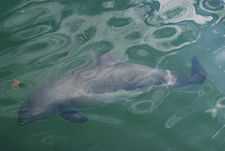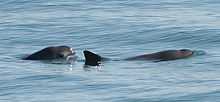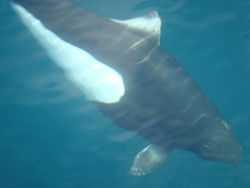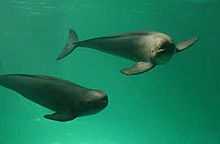Porpoise
| Porpoises Temporal range: 15.970–0Ma Miocene to Recent | |
|---|---|
 | |
| Phocoena phocoena, harbour porpoise near Denmark | |
| Scientific classification | |
| Kingdom: | Animalia |
| Phylum: | Chordata |
| Class: | Mammalia |
| Order: | Cetacea |
| Suborder: | Odontoceti |
| Superfamily: | Delphinoidea |
| Family: | Phocoenidae Gray, 1825 |
| Genera | |
|
See text | |
Porpoises (/ˈpɔrpəs/; also called mereswine) are small cetaceans of the family Phocoenidae; they are related to whales and dolphins. They are distinct from dolphins, although the word "porpoise" has been used to refer to any small dolphin, especially by sailors and fishermen. The most obvious visible difference between the two groups is that porpoises have shorter beaks and flattened, spade-shaped teeth distinct from the conical teeth of dolphins.
The name derives from Old French porpeis, for porc peis (Medieval Latin: porcus piscis), pig-fish.[1] The Modern French term marsouin is cognate to Old English mereswīn.
Porpoises, divided into six species, live in all oceans, and mostly near the shore. Freshwater populations of the finless porpoise also exist. Probably the best known species is the harbour porpoise, which can be found across the Northern Hemisphere. Like all toothed whales, porpoises are predators, using sounds (echolocation in sonar form) to locate prey and to coordinate with others. They hunt fish, squid, and crustaceans.
Taxonomy and evolution
Porpoises, along with whales and dolphins, are descendants of land-living ungulates (hoofed animals) that first entered the oceans around 50 million years ago (Mya). During the Miocene (23 to 5 Mya), mammals were fairly modern. The cetaceans diversified, and fossil evidence suggests porpoises and dolphins diverged from their last common ancestor around 15 Mya. The oldest fossils are known from the shallow seas around the North Pacific, with animals spreading to the European coasts and Southern Hemisphere only much later, during the Pliocene.[2]
Suborder Odontoceti toothed whales
- Infraorder Delphinida
- Superfamily Delphinoidea
- Family Phocoenidae - porpoises
- Genus †Haborophocoena[3]
- H. toyoshimai
- Genus Neophocaena
- N. phocaeniodes - Finless porpoise
- Genus †Numataphocoena[4]
- N. yamashitai
- Genus Phocoena
- P. phocoena - harbour porpoise
- P. sinus - vaquita
- P. dioptrica - spectacled porpoise
- P. spinipinnis - Burmeister's porpoise
- Genus Phocoenoides
- P. dalli - Dall's porpoise
- Genus †Septemriocetus[5]
- S. bosselaersii
- Genus †Piscolithax
- P. aenigmaticus
- P. longirostris
- P. boreios
- P. tedfordi
- Genus †Haborophocoena[3]
- Family Phocoenidae - porpoises
- Superfamily Delphinoidea
Recently discovered hybrids between male harbour porpoises and female Dall's porpoises indicate the two species may actually be members of the same genus.[6]
Species of porpoise
There are seven recognized species of porpoise.
| Species | Description | Image |
|---|---|---|
| Harbor porpoise (Phocoena phocoena) | The harbor porpoise is a solitary, small toothed whale that lives in cold water, that can be found in small pods of 2-5 individuals. Harbor porpoises have spade-shaped teeth, which makes them distinguishable from dolphins. They have a triangular dorsal fin, a dark gray back, and a white underbelly. Harbor porpoises give birth every year, with gestation lasting about 10 months. They feed on shoaling fish and squid in the cold waters of the North Pacific and the North Atlantic coastlines for their 24 year life span. They can weigh in at 61-77 kg, and can be 1.5-1.7 meters. [7] |  Harbor porpoise |
| Vacquita/Gulf of California harbor porpoise (Phocoena sinus) | The vacquita is a very elusive porpoise that inhabits the Gulf of California, in small pods of 7-10 individuals. The Vacquita was first described in 1958 by a series of skulls. They do not have robust bodies or beaks. Weighing in at 30-55 kg, and being 1.2-1.5 meters long, it is the smallest known cetacean. After a gestation period of 10-11 months, they usually give birth to one calf every other year, and have a lifespan of approximately 21 years. [8] |  A pair of vaquitas swim together. |
| Dall's porpoise (Phocoenoides dalli) or (Phocoenoides dalli truei) | Dall's porpoise describes two very fast subspecies of porpoise that are capable of diving 500 meters to feed on shoaling fish, cephalopods, and occasionally crustaceans in the North Pacific Ocean in pods of up to 20 individuals. P.d. truei inhabits the Western Pacific Ocean, whereas P. dalli inhabits the Northern Pacific. When they surface they create a rooster tail that is unique ability, among porpoises. They give birth every year and live generally 15-20 years, but can live to be 22. They weigh in at 220 kg and are 2-2.4 meters long. [9] |  Dall's porpoise |
| Burmeister's porpoise (Phocoena spinipinnus) | Burmeister's porpoise is a porpoise with a uniquely positioned dorsal fin, with a triangular dorsal fin angled backwards and set back farther than any other cetacean. The approximate 500 individuals inhabit the coast of Patagonia and eat small fish, mollusks, and cephalopods and have been heavily hunted for thousands of years. Burmeister's porpoise has a jet black to dark gray coloring, which gives it its nickname "the black porpoise". Burmeister's porpoise maximum length on record is 200 cm and the maximum weight is 79kg. [10] [11] |  Burmeister's porpoise size comparison |
| Spectacled porpoise (Phocoena dioptrica) | The spectacled porpoise is a rarely seen species of porpoise with a blue/black back and a white underbelly with no transitional colors between the blue and white, and pitch black patch around the eye. As a result of their elusiveness, almost nothing is known about the life of this species. Generally, spectacled porpoises travel in groups of 2, or travel alone. Sightings of them take place along the east coast of Patagonia and the Falkland Islands. They are a small species of porpoise, just measuring 1.3-2.2 meters and weighing 60-115 kg. [12] |  Illustration of a spectacled porpoise |
| Narrow-ridged finless porpoise (Neophocaenoides asiaorientalis) | The finless porpoise has two recognized subspecies: N. p. asiaorientalis which inhabits the Yangtze River, and N. p. sunameri which inhabits the coast of Taiwan to southern Japan. They have no fin, but instead have a ridge from their blowhole to their tail fluke. They have a blue/gray color and about half of them have pink eyes. They are officially protected in China, but are declining due to habitat destruction. They are 1.9 meters in length, weigh 30-45 kg, and are thought to live for between 10 and 20 years. Officially, their status is "Vulnerable", even though no official population count has been taken since it was split from the Indo-Pacific finless porpoise.[13] |  Two finless porpoises |
| Indo-Pacific finless porpoise (Neophocaenoides phocaenoides) | Originally considered the same species as the narrow ridged finless porpoise, the two were split into two different species in 2011[14] when it was proven that they could not breed together. The Indo-Pacific finless porpoise inhabits the coastline between the Persian Gulf and Taiwan. They have no fin, but instead have a ridge from their blowhole to their tail fluke. They have a blue/gray color and about half of them have pink eyes. They are officially protected in China, but are declining due to habitat destruction, and Pakistan has fisheries specifically targeting finless porpoises. They are 1.9 meters in length, weigh 30-45 kg, and are thought to live for between 10 and 20 years. Officially, their status is "Vulnerable", even though no official population count has been taken since it was split from the narrow-ridged finless porpoise.[15] |  Indo-Pacific finless porpoise |
Physical characteristics
_light.jpg)
Porpoises tend to be smaller but stouter than dolphins. They have small, rounded heads and blunt jaws instead of beaks. While dolphins have a round, bulbous "melon", porpoises do not. Their teeth are spade-shaped, whereas dolphins have conical teeth. In addition, a porpoise's dorsal fin is generally triangular, rather than curved like that of many dolphins and large whales. Some species have small bumps, known as tubercles, on the leading edge of the dorsal fin. The function of these bumps is unknown.[6]
These animals are the smallest cetaceans, reaching body lengths up to 2.5 metres (8.2 ft); the smallest species is the vaquita, reaching up to 1.5 metres (4.9 ft). In terms of weight, the lightest is the finless porpoise at 30 to 45 kilograms (66 to 99 lb), and the heaviest is Dall's porpoise at 130 to 200 kilograms (290 to 440 lb). Because of their small size, porpoises lose body heat to the water more rapidly than other cetaceans. Their stout shape, which minimizes surface area, may be an adaptation to reduce heat loss. Thick blubber also insulates them from the cold. The small size of porpoises requires them to eat frequently, rather than depending on fat reserves.[6]
Life history
Porpoises bear young more quickly than dolphins. Female Dall's and harbour porpoises often become pregnant with a single calf each year, and pregnancy lasts for about 11 months. Porpoises have been known to live 8–10 years, although some have lived to be 20.[6]
Behavior
Porpoises prey on fish, squid, and crustaceans. Although they are capable of dives up to 200 m, they generally hunt in shallow coastal waters. They are found most commonly in small groups of fewer than ten individuals, referred to as pods. Rarely, some species form brief aggregations of several hundred animals. Like all toothed whales, they are capable of echolocation for finding prey and group coordination. Porpoises are fast swimmers—Dall's porpoise is said to be one of the fastest cetaceans, with a speed of 55 km/h (34 mph). Porpoises tend to be less acrobatic and more sexually aggressive than dolphins.[16]
Humans and porpoises
Accidental entanglement (bycatch) in fishing nets is the main threat to porpoises today.[17] One of the most endangered cetacean species is the vaquita, having a limited distribution in the Gulf of California, a highly industrialized area. In some countries, porpoises are hunted for food or bait meat.
Porpoises are rarely held in captivity in zoos or oceanaria, as they are generally not as capable of adapting to tank life or as easily trained as dolphins.
Traditionally porpoises under English law were a royal fish which belonged to the Crown.[18]
See also
References
- ↑ Ernest Weekley The Romance of Words, Murray, London 1912
- ↑ Gaskin, David E. (1984). Macdonald, D., ed. The Encyclopedia of Mammals. New York: Facts on File. pp. 196–199. ISBN 0-87196-871-1.
- ↑ Ichishima, H. & Kimura, M.. 2005. "Harborophocoena toyoshimai, a new early Pliocene porpoise (Cetacea, Phocoenidae) from Hokkaido, Japan". Journal of Vertebrate Paleontology 25(3):655–664
- ↑ Ichishima, H. & Kimura, M.. 2000. "A new fossil porpoise (Cetacea; Delphinoidea; Phocoenidae) from the early Pliocene Horokaoshirarika Formation, Hokkaido, Japan". Journal of Vertebrate Paleontology 20(3):561–576
- ↑ Lambert, O.. 2008. "A new porpoise (Cetacea, Odontoceti, Phocoenidae) from the Pliocene of the North Sea". Journal of Vertebrate Paleontology 28(3):863–872
- ↑ 6.0 6.1 6.2 6.3 Read, Andrew (1999). Porpoises. Stillwater, MN, USA: Voyageur Press. ISBN 0-89658-420-8.
- ↑ http://www.nmfs.noaa.gov/pr/species/mammals/cetaceans/harborporpoise.htm
- ↑ http://www.nmfs.noaa.gov/pr/species/mammals/cetaceans/vaquita.htm
- ↑ http://www.nmfs.noaa.gov/pr/species/mammals/cetaceans/dallsporpoise.htm
- ↑ http://www.cms.int/reports/small_cetaceans/data/p_spinipinnis/p_spinipinnis.htm
- ↑ http://marinebio.org/species.asp?id=439
- ↑ http://marinebio.org/species.asp?id=440
- ↑ http://marinebio.org/species.asp?id=438
- ↑ http://www.iucn-csg.org/index.php/2011/07/05/new-red-list-assessments-for-two-species-of-finless-porpoises/
- ↑ http://us.whales.org/species-guide/indo-pacific-finless-porpoise
- ↑ http://appreviews4u.com/2013/03/11/porpoises-the-ignored-species/
- ↑ "Phocoena sinus".
- ↑ Hale De Jure Maris c.7
External links
![]() Media related to Phocoenidae at Wikimedia Commons
Media related to Phocoenidae at Wikimedia Commons